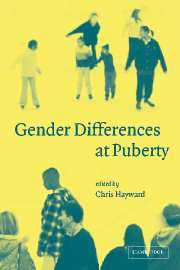Book contents
- Frontmatter
- Contents
- List of figures
- List of tables
- List of contributors
- Preface
- Acknowledgments
- 1 Methodological concerns in puberty-related research
- Part 1 Sex differences in hormones and their effect at puberty
- Part 2 Girls at puberty
- 4 Puberty and body image
- 5 Gender differences in opposite sex relationships: interactions with puberty
- 6 Aggression, psychopathology, and delinquency: influences of gender and maturation – where did all the good girls go?
- Part 3 Boys at puberty
- Part 4 Puberty and psychopathology
- Part 5 Pubertal timing: antecedents
- Part 6 Pubertal timing: consequences
- Part 7 Puberty and context
- Index
- References
6 - Aggression, psychopathology, and delinquency: influences of gender and maturation – where did all the good girls go?
Published online by Cambridge University Press: 22 September 2009
- Frontmatter
- Contents
- List of figures
- List of tables
- List of contributors
- Preface
- Acknowledgments
- 1 Methodological concerns in puberty-related research
- Part 1 Sex differences in hormones and their effect at puberty
- Part 2 Girls at puberty
- 4 Puberty and body image
- 5 Gender differences in opposite sex relationships: interactions with puberty
- 6 Aggression, psychopathology, and delinquency: influences of gender and maturation – where did all the good girls go?
- Part 3 Boys at puberty
- Part 4 Puberty and psychopathology
- Part 5 Pubertal timing: antecedents
- Part 6 Pubertal timing: consequences
- Part 7 Puberty and context
- Index
- References
Summary
I don't know why I did it, I don't know why I enjoyed it, and I don't know why I'll do it again.
Bart Simpson, young character from The Simpsons, US animated television showIn this chapter we will summarize the problems of aggression and their relationship to gender and maturation. We will first discuss aggression as a normative behavior and examine gender differences and their relationship to puberty. We will then focus on psychopathological forms of aggression, such as disruptive behavior disorders, again relating them to gender and pubertal development; we will conclude with a discussion of gender differences in delinquency. In each of these subsections, we will cite research that approaches the topic from an experimental, naturalistic, and clinical perspective.
Aggression as a normative behavior: gender differences
To understand gender differences in aggression and violence, one can take a developmental approach and examine the presence of aggression through the various life stages (Loeber and Hay, 1997). During infancy signs of frustration and rage can be observed, though significant gender differences cannot be detected. Research conducted by Weinberg and colleagues (1999) found gender differences in the emotional expressiveness among infants, although it is unclear if these differences are precursors to aggression. Infant girls were able to regulate their emotional states better than infant boys, who were more likely to show anger. During the toddler stage minimal gender differences were found to exist, but research findings are conflicted.
- Type
- Chapter
- Information
- Gender Differences at Puberty , pp. 93 - 110Publisher: Cambridge University PressPrint publication year: 2003
References
- 3
- Cited by



